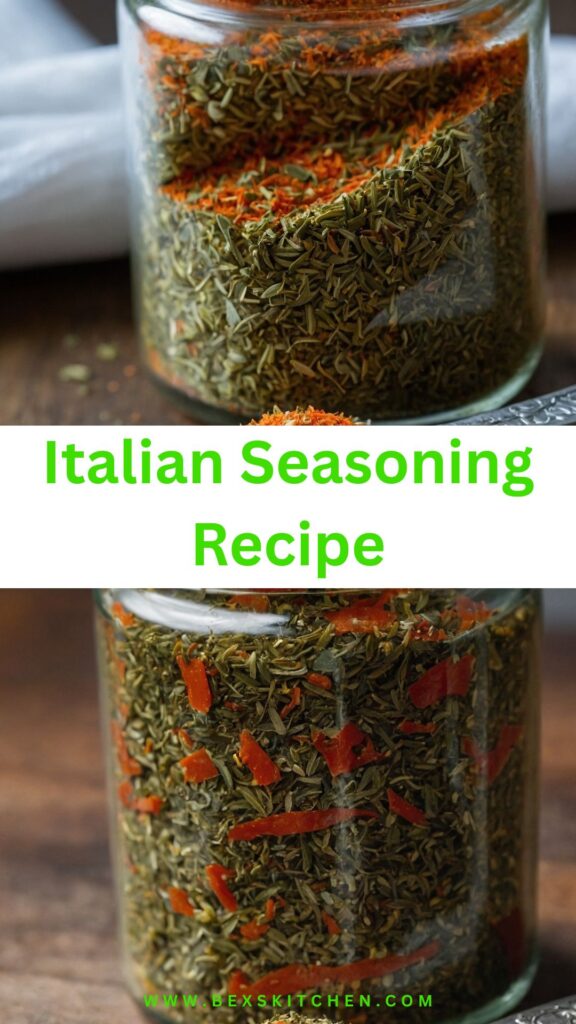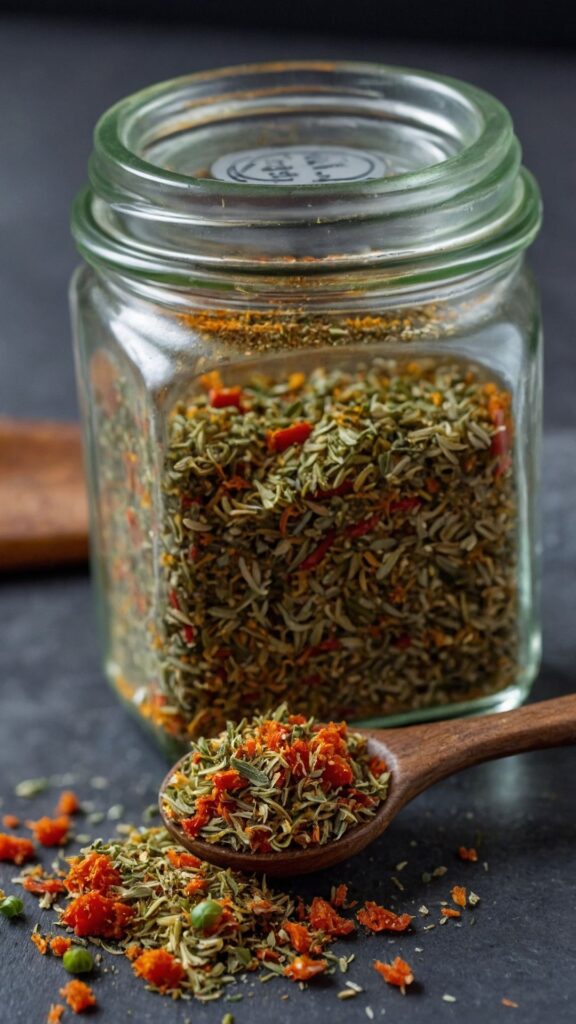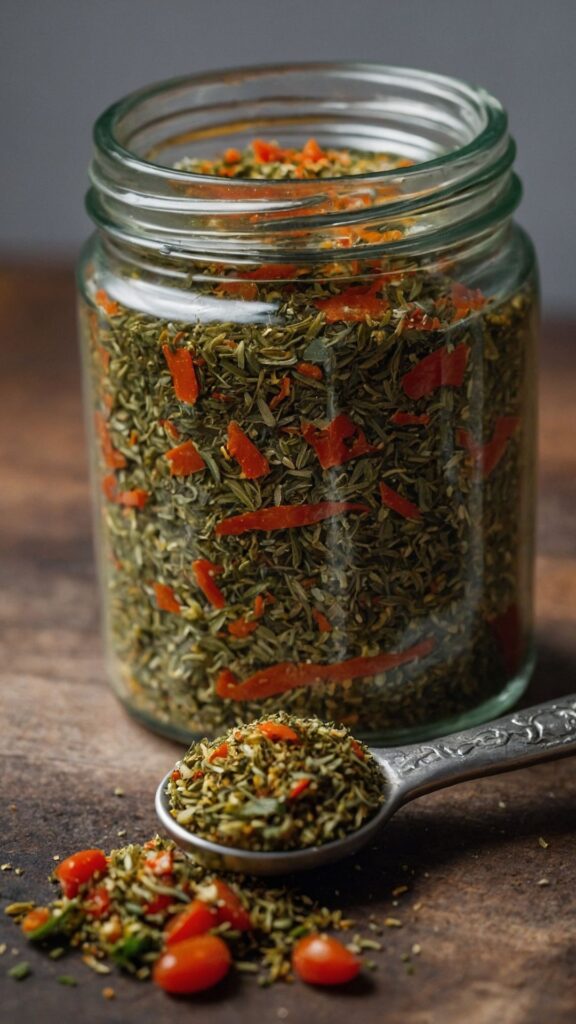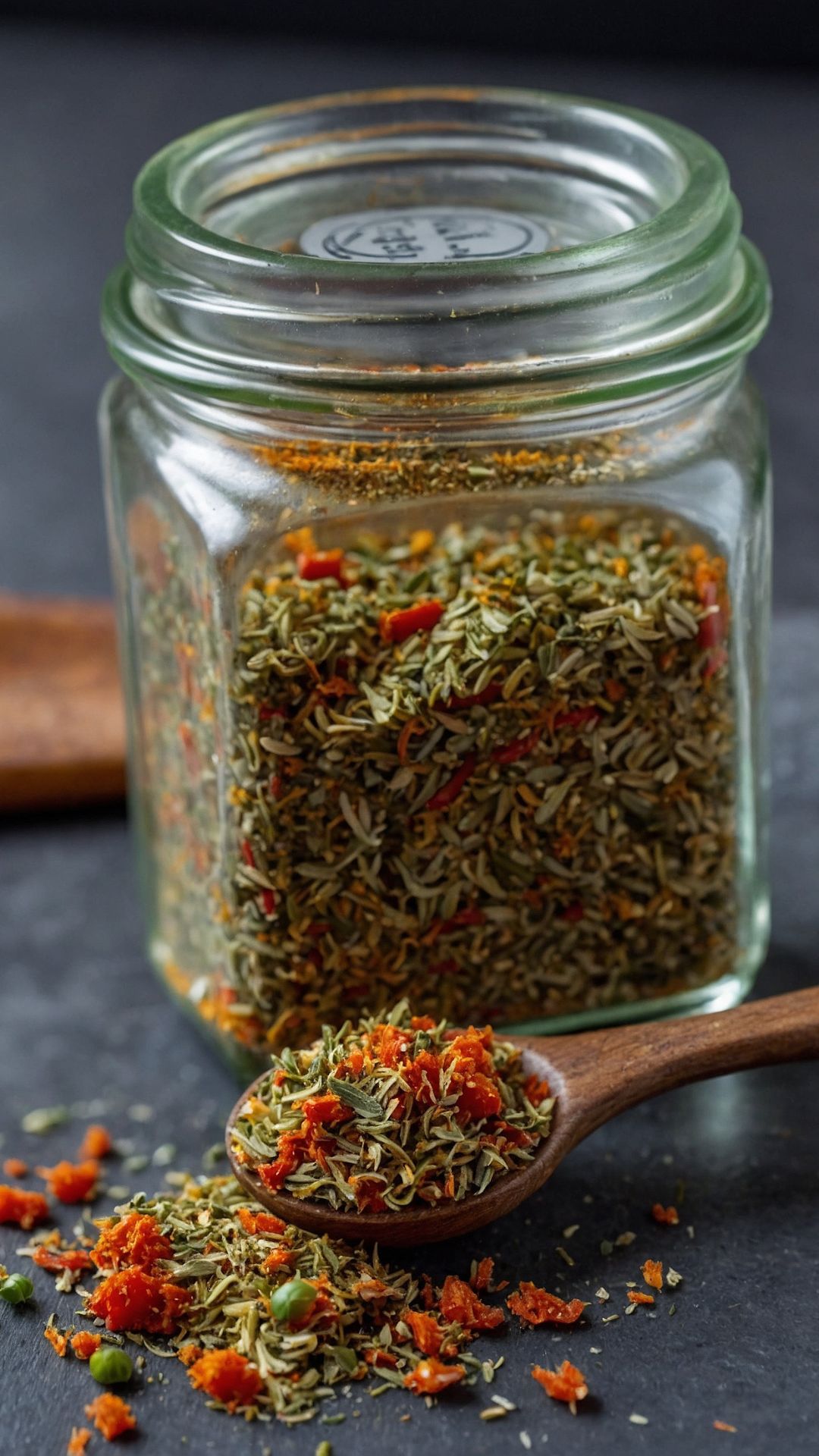Whenever I think of comfort food, my mind drifts to a vivid summer gathering where laughter fills the air. Picture this: a long table adorned with an array of colorful dishes, topped with vibrant salads and steaming pastas.
One dish that always turns heads and makes taste buds dance is Italian pasta salad. It’s an effortless blend of ingredients—a delightful mix of fusilli noodles, chickpeas, pepperoncini peppers, and an assortment of fresh, crunchy vegetables like bell peppers and tomatoes.
I’m convinced that the magic lies in the seasoning, and that’s why I love crafting my own Italian seasoning blend. The aroma wafts through the kitchen, evoking memories of summer days spent sharing meals with friends and family. It’s a blend that is also a versatile companion for many dishes. Let’s dive into this delightful recipe together!

What is Italian Seasoning?
At its core, Italian seasoning is a herb blend that embodies the essence of Italian cooking. It’s a wonderful mix of dried herbs that brings a taste of Italy right into your kitchen.
While various variations exist, a classic Italian seasoning features herbs that harmonize beautifully. They can elevate a basic pasta dish, enhance roasted vegetables, or even give your homemade pizza a zing.
You will also like the following Appetizer recipes!
The Ingredients
Creating your own Italian seasoning blend not only ramps up flavor but also allows you to avoid those questionable store-bought versions packed with preservatives. Here’s what you’ll need:
1 tablespoon dried rosemary needles: This brings a piney, woody essence to the mix.
2 tablespoons Mediterranean oregano: Known for its bold flavor, it adds a slightly bitter herbal note.
½ teaspoon ground black pepper: Just enough to round out the blend with a mild spiciness.
2 tablespoons dried sweet basil: Offers warm, peppery tones with hints of mint.
1 teaspoon onion powder: This sweet onion flavor complements other spices beautifully.
1 tablespoon red chili flakes: A pinch of fiery heat to liven things up.
2 tablespoons crushed dried parsley leaves: For a fresh, grassy brightness.
1 tablespoon dried thyme flakes: An earthy flavor with subtle minty notes.
1 teaspoon garlic powder: Adds a savory depth and umami punch that’s hard to resist.

How to Make Italian Seasoning Recipe
This Italian seasoning recipe is simple and straightforward. I promise it will become a staple in your kitchen. Let’s start with the preparation!
Step 1: Gather Your Ingredients
Make sure all the herbs and spices are fresh. You’ll get the best flavor from quality ingredients. Measure them accurately using dry measuring spoons to ensure balanced ratios.
Step 2: Combine Herbs and Spices
In a medium-sized mixing bowl, combine all the herbs and spices you’ve gathered. Use a shallow bowl to help prevent spills.
Step 3: Blend Together
Using a whisk or a fork, mix the ingredients until they are well combined. This step is vital to make sure every pinch of seasoning has a balanced flavor.
Step 4: Taste Test
Now is the time to be adventurous! Take a small pinch and taste it. Adjust any herbs based on your preference. If you love a bit more heat, sprinkle in extra chili flakes. If basil does it for you, don’t hold back!
Step 5: Store for Later Use
Transfer the mixture to an airtight container or spice jar. Label it with the date and contents to keep track of freshness. Make sure to store it in a cool, dark place.
Notes: Pro Tips for Perfecting Your Seasoning
Here are some helpful tips to make the most of your homemade Italian seasoning:
Freshness is Key: Dried herbs maintain their potency for longer when stored in a cool spot.
Experiment: Don’t hesitate to play around with the quantities. The beauty of cooking is in the creativity.
Use a Mortar and Pestle: If you want a finer blend, crush herbs slightly before mixing. This releases essential oils and flavors.
Make Ahead: This seasoning lasts for months, making it perfect for meal prepping your week.
Label it: If you’re crafting several spice blends, clearly label everything to avoid mix-ups!
Storage Tips
Your homemade Italian seasoning can last up to six months if stored properly. Here are a few storage tips to ensure it stays fresh:
Store in a glass jar with a tight seal to protect from air exposure.
Avoid direct sunlight; opt for a cupboard or pantry.
For longer freshness, keep it refrigerated (though this is not necessary).
Nutrition Information
While most seasoning blends are typically used in small amounts, here’s a rough estimate per teaspoon:
Calories: 5 kcal
Carbohydrates: 1g
Protein: 0.3g
Fat: 0g
Fiber: 0g
Sodium: 0g (This blend is naturally sodium-free)
These values may vary based on specific brand ingredients and measurements.
Serving Suggestions
Now that you’ve prepared your Italian seasoning, here are five delicious ways to use it!
1. Salad Dressing: Whisk 2 tablespoons of the seasoning with olive oil and vinegar for a zesty dressing. It livens up any salad, particularly pasta salads or leafy greens.
2. Marinade: Mix the seasoning with olive oil and lemon juice to create a marinade for chicken or vegetables. The flavors penetrate beautifully when marinating overnight.
3. Pizza Topping: Sprinkle generously over homemade pizza or garlic bread. This adds an authentic Italian touch that’s truly irresistible.
4. Roasted Vegetables: Toss your favorite vegetables in olive oil and Italian seasoning before roasting. You’ll be surprised by how good broccoli, carrots, or zucchini can taste!
5. Pasta Dishes: A simple pasta dish can transform with a sprinkle of this seasoning. Mix it into your tomato or cream sauce to amplify flavors.

What Other Substitutes Can I Use in Italian Seasoning Recipe?
If you find yourself missing some ingredients, here are some substitutes that work well:
1. Dried Herbs de Provence: This blend includes herbs commonly found in Italian seasoning. Just know that it has a unique floral hint.
2. Italian Parsley: If you don’t have dried parsley, fresh parsley can give your recipe similar freshness. Just double the amount.
3. Fresh Garlic: If you’re out of garlic powder, a freshly minced garlic clove can bring excellent flavor if added to dishes during cooking.
4. Fresh Basil: When fresh basil is available, it adds lush flavor in lieu of dried. Try fresh basil in salads or as a pasta topper.
5. Fennel Seeds: If you enjoy a sweeter flavor, fennel seeds can replace some of the rosemary’s intensity in your Italian seasoning. Use sparingly!

Equipment
- bowl
- whisk
Ingredients
- 1 tablespoon dried rosemary needles: This brings a piney woody essence to the mix.
- 2 tablespoons Mediterranean oregano: Known for its bold flavor it adds a slightly bitter herbal note.
- ½ teaspoon ground black pepper: Just enough to round out the blend with a mild spiciness.
- 2 tablespoons dried sweet basil: Offers warm peppery tones with hints of mint.
- 1 teaspoon onion powder: This sweet onion flavor complements other spices beautifully.
- 1 tablespoon red chili flakes: A pinch of fiery heat to liven things up.
- 2 tablespoons crushed dried parsley leaves: For a fresh grassy brightness.
- 1 tablespoon dried thyme flakes: An earthy flavor with subtle minty notes.
- 1 teaspoon garlic powder: Adds a savory depth and umami punch that’s hard to resist.
Instructions
Step 1: Gather Your Ingredients
- Make sure all the herbs and spices are fresh. You’ll get the best flavor from quality ingredients. Measure them accurately using dry measuring spoons to ensure balanced ratios.
Step 2: Combine Herbs and Spices
- In a medium-sized mixing bowl, combine all the herbs and spices you’ve gathered. Use a shallow bowl to help prevent spills.
Step 3: Blend Together
- Using a whisk or a fork, mix the ingredients until they are well combined. This step is vital to make sure every pinch of seasoning has a balanced flavor.
Step 4: Taste Test
- Now is the time to be adventurous! Take a small pinch and taste it. Adjust any herbs based on your preference. If you love a bit more heat, sprinkle in extra chili flakes. If basil does it for you, don’t hold back!
Step 5: Store for Later Use
- Transfer the mixture to an airtight container or spice jar. Label it with the date and contents to keep track of freshness. Make sure to store it in a cool, dark place.
Notes
- Freshness is Key: Dried herbs maintain their potency for longer when stored in a cool spot.
- Experiment: Don’t hesitate to play around with the quantities. The beauty of cooking is in the creativity.
- Use a Mortar and Pestle: If you want a finer blend, crush herbs slightly before mixing. This releases essential oils and flavors.
- Make Ahead: This seasoning lasts for months, making it perfect for meal prepping your week.
- Label it: If you’re crafting several spice blends, clearly label everything to avoid mix-ups!
Nutrition
Frequently Asked Questions
1. Can I use fresh herbs instead of dried?
Absolutely! However, you’ll need to adjust the measurements accordingly. A general rule is to use three times the amount for fresh herbs compared to dried.
2. How long does homemade Italian seasoning last?
When stored properly in a cool, dark place, it can last up to six months before it starts to lose flavor.
3. Is Italian seasoning gluten-free?
Yes, this blend is gluten-free, making it a safe option for those with gluten sensitivities.
4. Can I add other spices to customize my blend?
Yes, feel free to add spices like smoked paprika or herbs like sage or dill to create your own signature Italian seasoning.
5. Does Italian seasoning contain salt?
Normally, it does not. This makes it a versatile way to season dishes without adding additional sodium. Simply adjust to your dietary needs.
Conclusion
Crafting your own Italian seasoning recipe opens a door to a world of flavor in your cooking. It’s about bringing the spirit of Italian cuisine to your table, inspiring creativity, and making meals more enjoyable. Whether tossed into pasta, used as a marinade, or sprinkled over roasted vegetables, you’ll elevate your dishes instantly.
So the next time you host a gathering or whip together a simple dinner, remember that your homemade Italian seasoning is a trusty companion, making every bite unforgettable. Now, roll up your sleeves and get cooking—your taste buds will thank you!
